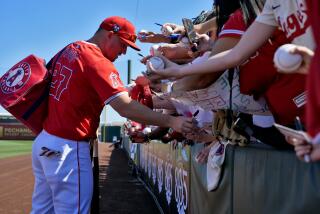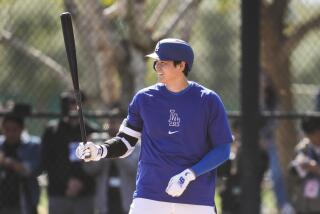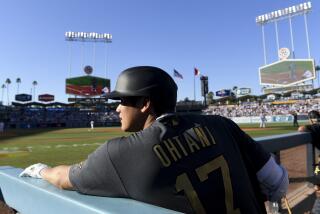INDIAN SUMMER OR FALL? : After 30 Years of Frustration, Cleveland May Have a Team That the City Can Be Proud Of
- Share via
TUCSON — As the Boston Red Sox were wrapping up the American League East championship last September, Sparky Anderson was asked about 1987.
“If I had to pick a winner, I’d have to take the Indians,” he said.
Anderson has been wrong before, of course, but the Detroit Tiger manager isn’t the only one forecasting an Indian summer.
USA Today and Sport magazine are also picking Cleveland in the AL East, and the Sporting News and Sports Illustrated are planning cover stories on the Indians’ re-emergence.
Finally, after more than 30 years of grinning and bearing it, there may be good reason for that smile on the face of Chief Wahoo, the Indians’ mascot.
As General Manager Joe Klein is fond of saying these days: “Why not?”
Why not, indeed.
After equaling a franchise record by losing 102 games in 1985, the Indians improved to 84-78 last season, their best record in 18 years. They finished fifth in the East, 11 1/2 games behind Boston, the closest they’ve been to first place since 1959.
Although pitching continues to be a concern, they had a team batting average of .284, the fifth highest in the major leagues since World War II, and led the American League in runs scored, hits, stolen bases, total bases, triples and fewest times shut out.
In a year in which Bill Madlock led the Dodgers with 60 runs batted in, the Indians had seven players with 66 or more RBIs, including Joe Carter, who led the majors with 121, and rookie Cory Snyder, who had 69 in only 103 games.
“Best offense in baseball,” left fielder Mel Hall calls it.
The city of Cleveland took notice, pouring into cavernous Municipal Stadium--capacity: 74,208--like at no other time since 1959, when the Indians finished five games behind the Chicago White Sox.
The Indians drew 1,471,977 fans last season, an increase of 816,796 over 1985, and are talking about surpassing the 2-million mark for the first time since 1949.
“We aren’t funny anymore,” Carter said. “We’ve earned respect.”
But can they win the East title?
Are the Indians for real?
“Oh, we’re for real,” Hall said. “We’re going to win a lot of games.”
Hall, acquired along with Carter in the 1984 trade that sent pitcher Rick Sutcliffe to the Chicago Cubs, last year labeled this group of castoffs as misfits.
“We’ve got nobody from the organization,” Hall said. “Everybody’s from different ballclubs.”
Of the 10 pitchers and 10 regulars, only three--Snyder, catcher Chris Bando and pitcher Greg Swindell--were originally signed by the Cleveland organization.
The rest were acquired in trades, plucked from other teams’ minor league systems, picked up as free agents or off the waiver wire.
Its minor league system in disarray, Cleveland traded some big-name pitchers in recent years--Sutcliffe, Bert Blyleven, Len Barker--getting some good, young players in return and casting an eye toward the future.
“They’ve tried to gear this club toward ‘88,” said center fielder Brett Butler, who came over with All-Star third baseman Brook Jacoby in the 1983 trade that sent Barker to Atlanta. “But if we won in ‘87, I don’t think anybody would gripe.”
The Indians have put together an offense that is not only potent, but young, too. Of the seven players who produced 66 or more RBIs last season, only one--designated hitter Andre Thornton--has celebrated his 30th birthday.
“There’s a real good chance that we haven’t peaked yet offensively,” Klein said.
He points to these factors:
--Butler, who batted .311 in 1985, dropped 33 points in 1986, scored fewer than 100 runs for the first time in three years and had to hit .381 in September just to reach .278.
--Snyder, who spent the first two months of last season in Triple-A, will be with the Indians all season this time around.
--Hall, who hit .296 with 18 home runs and 77 RBIs after missing almost all of ’85 because of injuries suffered in an auto accident, hit only two home runs after the All-Star break.
--Thornton, who had 17 home runs and 66 RBIs despite being limited by injuries to 120 games, should be better after undergoing his fourth knee operation.
--The addition of catcher Rick Dempsey, a 14-year veteran who hit 11, 12 and 13 home runs in his last three seasons in Baltimore, should provide a little more power. Last season, Indian catchers Bando and Andy Allanson hit only three home runs between them.
Dempsey’s greatest influence, though, is expected to be felt by Cleveland’s beleaguered pitching staff, which was almost completely overhauled after the Indians had posted a team earned-run average of 4.91 in 1985, the highest in the 85-year history of the franchise and the highest in the majors since the 1962 New York Mets.
They improved to 4.58 last season, when they got only seven victories from pitchers who were on the roster in 1985, but were still 12th in the league.
They weren’t helped any by a defense that led the league with 157 errors, including 20 by Allanson, who was attempting to make the jump from Double-A.
This season, Klein expects the Indians to improve to at least the middle of the pack in both ERA and errors with the addition of Dempsey, free-agent pitchers Dennis Lamp and Ed Vande Berg and Tom Waddell, who missed last season with an elbow injury.
Vande Berg had a 1-5 record with no saves as a Dodger last season, but was effective in the four previous seasons with the Seattle Mariners. Lamp was only 2-6 with a 5.05 ERA with Toronto last season, but was 11-0 with a 3.32 ERA when the Blue Jays won the East title in 1985.
Vande Berg, Lamp and Waddell will be counted on to help the Indians’ middle relief, the team’s glaring weakness last season.
The ERA last season of the Cleveland relievers who came into games in which the starter had failed to go at least five innings was 5.81, Klein said.
“If we took a starter out who was losing, 4-3, it was 7-3 before we knew it,” Klein said.
The Indians’ five-man rotation isn’t going to scare anybody, but it also should be improved simply because Greg Swindell will be available all season.
Drafted last June, Swindell was in the majors only three weeks after he signed--a total of three starts in Class A under his belt.
He was knocked around in his first start, a 24-5 loss to the Red Sox, but pitched into the seventh inning seven times in his last eight starts and was 5-1.
“He’s got a lot of poise on the mound,” Manager Pat Corrales said of the 22-year-old left-hander, a three-time All-American at the University of Texas. “In fact, he pitches as if he’s been in the big leagues for 10 years.”
It has been suggested, not by Corrales, that Swindell might be to the Indians what another Texas alum, Roger Clemens, was to the Red Sox last season.
The other starters are Scott Bailes, who made the jump from Double-A last season, All-Star Ken Schrom, 14-7 last year, and knuckleballers Phil Niekro and Tom Candiotti, who was 16-12 last season, led the league with 17 complete games and pitched into the seventh inning in 28 of his 34 starts, including the last 22.
“None of us are big stoppers but we all have the ability to keep our team in the game,” Candiotti said. “And with the offense we have, I think that’s all we need to do.”
The No. 1 short reliever is Ernie Camacho, who had 20 saves last season and is said to throw as hard as anybody in the league.
So the Indians, who last won the American League pennant in 1954 and haven’t even been a serious contender since 1959, are moving forward.
They have two “franchise players,” Klein said, in Snyder and Carter, whose 200 hits in 1986 included 29 home runs, and two more on the way in shortstop Jay Bell and third baseman Eddie Williams, who will form the left side of the infield at Triple-A Buffalo this season.
Four Indians hit .300 last season--Carter, .302; shortstop Julio Franco, .306; second baseman Tony Bernazard, .301, and first baseman Pat Tabler, .326. Tabler ranked fourth in the league but will almost surely be used in a platoon role again this season.
“We’re starting to smell the light air for the first time in 30 years,” Klein said.
But can they reach the heights this season?
Their 24-game improvement last season included no improvement at all against the teams in their own division, their 32-46 record in 1986 matching their 1985 mark. They got fat against the West, posting a 52-32 record. Schrom was 10-0 against the West.
Their ERA against the East was 5.19 despite a 2.65 ERA against the last-place Baltimore Orioles, and they were 6-20 against the Red Sox and Blue Jays.
But Klein believes that left-handers Swindell and Bailes, neither of whom was in the Indians’ rotation at the beginning of last season, should help neutralize the Red Sox’s left-handed hitters and that the possible addition of rookie Dave Clark, who hit 19 home runs in Triple-A last season, should give the Indians’ more left-handed strength off the bench against Toronto’s right-handed relievers.
And the left-handed Vande Berg, he said, will be called on to hold down the Tigers’ left-handed pinch-hitters. The Indians were 4-9 against Detroit.
“If we match up better against those teams, and do what we’re supposed to do against everybody else, it should make us five or six games better,” Klein said.
That would bring the Indians to about 90 wins, and Klein said: “Because of where we’re coming from, the lower the winning number, the better off we’ll be. We can handle 90 or 92 wins.”
So, with the Cincinnati Reds being picked in some circles to win the National League West, how about an all-Ohio World Series this October between the Indians and the Reds?
“Why not?” said Klein.
More to Read
Go beyond the scoreboard
Get the latest on L.A.'s teams in the daily Sports Report newsletter.
You may occasionally receive promotional content from the Los Angeles Times.










